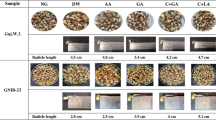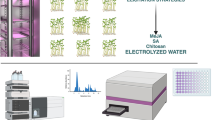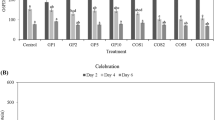Abstract
Sprouts of cereal grains, such as barley (Hordeum vulgare L.), are a good source of beneficial phenolic bioactives. Such health relevant phenolic bioactives of cereal sprouts can be targeted to manage chronic hyperglycemia and oxidative stress commonly associated with type 2 diabetes (T2D). Therefore improving phenolic bioactives by stimulating plant endogenous defense responses such as protective pentose phosphate pathway (PPP) during sprouting has significant merit. Based on this metabolic rationale, this study aimed to enhance phenolic bioactives and associated antioxidant and anti-hyperglycemic functions in dark germinated barley sprouts using exogenous elicitor treatments. Dark-germinated sprouts of two malting barley cultivars (Pinnacle and Celebration), treated with chitosan oligosaccharide (COS) and marine protein hydrolysate (GP), were evaluated. Total soluble phenolic content (TSP), phenolic acid profiles, total antioxidant activity (TA) and in vitro inhibitory activities of hyperglycemia relevant α-amylase and α-glucosidase enzymes of the dark germinated barley sprouts were evaluated at day 2, 4, and 6 post elicitor treatments. Overall, TSP content, TA, and α-amylase inhibitory activity of dark germinated barley sprouts decreased, while α-glucosidase inhibitory activity and gallic acid content increased from day 2 to day 6. Among barley cultivars, high phenolic antioxidant-linked anti-hyperglycemic bioactives were observed in Celebration. Furthermore, GP and COS seed elicitor treatments in selective doses improved T2D relevant phenolic-linked anti-hyperglycemic bioactives of barley spouts at day 6. Therefore, such seed elicitation approach can be strategically used to develop bioactive enriched functional food ingredients from cereal sprouts targeting chronic hyperglycemia and oxidative stress linked to T2D.

Similar content being viewed by others
References
Ali Asgar M (2013) Anti-diabetic potential of phenolic compounds: a review. Int J Food Prop 16:91–103
Andarwulan N, Shetty K (1999) Improvement of pea (Pisum sativum) seed vigour response by fish protein hydrolysates in combination with acetyl salicylic acid. Process Biochem 35:159–165
Babu PVA, Liu D (2008) Green tea catechins and cardiovascular health: an update. Curr Med Chem 15:1840–1850
Baik B, Ullrich SE (2008) Barley for food: characteristics, improvement, and renewed interest. J Cereal Sci 48:233–242
Cervato G, Carabelli M, Gervasio S, Cittera A, Cazzola R, Cestaro B (2000) Antioxdant properties of oregano (Origanum vulgare) leaf extracts. J Food Biochem 24:453–465
du Jardin P (2015) Plant biostimulants: definition, concept, main categories and regulation. Sci Hortic 196:3–14
Dykes L, Rooney LW (2007) Phenolic compounds in cereal grains and their health benefit. Cereal Food World 52:105–111
Fowler MJ (2008) Microvascular and macrovascular complications of diabetes. Clin Diabetes 26:77–82
Ha KS, Jo SH, Mannam V, Kwon YI, Apostolidis E (2016) Stimulation of phenolics, antioxidant and α-glucosidase inhibitory activities during barley (Hordeum vulgare L.) seed germination. Plant Food Hum Nutr 71:211–217
Hanhineva K, Torronen R, Bondia-Pons I, Pekkinen J, Kolehmainen M, Mykkanen H, Poutanen K (2010) Impact of dietary polyphenols on carbohydrate metabolism. Int J Mol Sci 11:1365–1402
Huang D, Ou B, Hampsch-Woodill M, Flanagan JA, Prior RL (2002) High-throughput assay of oxygen radical absorbance capacity (ORAC) using a multichannel liquid handling system coupled with a microplate fluorescence reader in 96-well format. J Agric Food Chem 50:4437–4444
Hübner F, Arendt EK (2013) Germination of cereal grains as a way to improve the nutritional value: a review. Crit Rev Food Sci Nutr 53:853–861
Iacopini P, Baldi M, Storchi P, Sebastiani L (2008) Catechin, epicatechin, quercetin, rutin and resveratrol in red grape: content, in vitro antioxidant activity and interactions. J Food Compos Anal 21:589–598
Inzucchi SE, Bergenstal RM, Buse JB, Diamant M, Ferrannini E, Nauck M, Peters AL, Tsapas A, Wender R, Matthews DR (2015) Management of hyperglycaemia in type 2 diabetes, 2015: a patient-centred approach. Update to a position statement of the American diabetes association and the European association for the study of diabetes. Diabetologia 58:429–442
Kähkönen MP, Hopia AU, Vuorela HJ, Rauha J, Pihlaja K, Kujala T, Hainonen M (1999) Antioxidant activity of plant extracts containing phenolic compounds. J Agric Food Chem 47:3957–3962
Kahn SE (2003) The relative contributions of insulin resistance and beta-cell dysfunction to the pathophysiology of Type 2 diabetes. Diabetologia 46:3–19
Kakkar S, Bais S (2014) A review on protocatechuic acid and its pharmacological potential. ISRN Pharmacol. doi:10.1155/2014/952943
Kwon YI, Vattem DA, Shetty K (2006) Evaluation of clonal herbs of Lamiaceae species for management of diabetes and hypertension. Asia Pac J Clin Nutr 15:107–118
Kwon YI, Apsotolidis E, Kim YC, Shetty K (2007) Health benefits of traditional corn, beans, and pumpkin: in vitro studies for hyperglycemia and hypertension management. J Med Food 10:266–275
Lee W, Lee SY, Son YJ, Yun JM (2015) Gallic acid decreases inflammatory cytokine secretion through histone acetyltransferase/histone deacetylase regulation in high glucose-induced human monocytes. J Med Food 18:793–801
Li X, Wang X, Chen D, Chen S (2011) Antioxidant activity and mechanism of protocatechuic acid in vitro. Funct Food Health Dis 1:232–234
Nair SS, Kavrekar V, Mishra A (2013) In vitro studies on alpha amylase and alpha glucosidase inhibitory activities of selected plant extracts. Eur J Exp Biol 3:128–132
Oboh G, Ogunsuyi OB, Ogunbadejo MD, Adefegha SA (2016) Influence of gallic acid on α-amylase and α-glucosidase inhibitory properties of acarbose. J Food Drug Anal 24:627–634
Orwat J (2016) Phenolic antioxidant-linked bioactive enrichment in black beans (Phaseolus vulgaris L.) to screen for health benefits and enhancement of salinity resilience. ProQuest Dissertations & Theses. http://gradworks.umi.com/10/15/10150593.html. Accessed 7 Apr 2017
Ramakrishna R, Sarkar D, Schwarz P, Shetty K (2017) Phenolic linked anti-hyperglycemic bioactives of barley (Hordeum vulgare L.) cultivars as nutraceuticals targeting type 2 diabetes. Ind Crops Prod. http://dx.doi.org/10.1016/j.indcrop.2017.03.033. (in press)
Randhir R, Lin YT, Shetty K (2004) Stimulation of phenolics, antioxidant and antimicrobial activities in dark germinated mung bean sprouts in response to peptide and phytochemical elicitors. Process Biochem 39:637–646
Randhir R, Kwon YI, Shetty K (2009) Improved health-relevant functionality in dark germinated Mucuna pruriens sprouts by elicitation with peptide and phytochemical elicitors. Bioresour Technol 100:4507–4514
Re R, Pellegrini N, Proteggente A, Pannala A, Yang M, Rice-Evans C (1999) Antioxidant activity applying an improved ABTS radical cation decolorization assay. Free Radic Biol Med 26:1231–1237
Sarkar D, Shetty K (2014) Metabolic stimulation of plant phenolics for food preservation and health. Annu Rev Food Sci Technol 5:395–413
Shetty K, Wahlqvist M (2004) A model for the role of the proline-linked pentose-phosphate pathway in phenolic phytochemical bio-synthesis and mechanism of action for human health and environmental applications. Asia Pac J Clin Nutr 13:1–24
Shetty K, Curtis OF, Levin R, Ang W (1995) Prevention of vitrification associated with in vitro shoot culture of oregano (Origanum vulgare) by Pseudomonas spp. J Plant Physiol 147:447–451
Stumvoll M, Goldstein BJ, Van Haeften TW (2005) Type 2 diabetes: principles of pathogenesis and therapy. Lancet 365:1333–1346
Trouvelot S, Heloir M, Poinssot B, Gauthier A, Paris F, Guillier C, Combier M, Trda L, Daire X, Adrian M (2014) Carbohydrates in plant immunity and plant protection: roles and potential application as foliar sprays. Front Plant Sci. doi:10.3389/fpls.2014.00592
Tundis R, Loizzo MR, Menichini F (2010) Natural products as alpha-amylase and alpha-glucosidase inhibitors and their hypoglycaemic potential in the treatment of diabetes: an update. Mini Rev Med Chem 10:315–331
Author information
Authors and Affiliations
Corresponding author
Rights and permissions
About this article
Cite this article
Ramakrishna, R., Sarkar, D., Manduri, A. et al. Improving phenolic bioactive-linked anti-hyperglycemic functions of dark germinated barley sprouts (Hordeum vulgare L.) using seed elicitation strategy. J Food Sci Technol 54, 3666–3678 (2017). https://doi.org/10.1007/s13197-017-2828-9
Revised:
Accepted:
Published:
Issue Date:
DOI: https://doi.org/10.1007/s13197-017-2828-9




